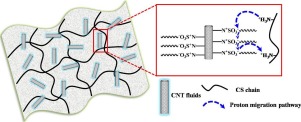Carbohydrate Polymers ( IF 11.2 ) Pub Date : 2018-01-11 , DOI: 10.1016/j.carbpol.2018.01.032 Jie Wang , Chunli Gong , Sheng Wen , Hai Liu , Caiqin Qin , Chuanxi Xiong , Lijie Dong

|
Poor dispersion and inert ionic conduction are two major obstacles towards using carbon nanotubes (CNTs) to modify polymer electrolyte membranes (PEMs) in energy conversion devices. In this work, solvent-free carbon nanotube fluids (CNT fluids) with liquid-like behavior are prepared through an ion exchange method and incorporated into a chitosan (CS) matrix to fabricate composite membranes. The electrostatic interactions between −SO3− groups in the CNT fluids and −NH2 groups in the CS matrix, in addition to the unique flow properties of the CNT fluids, promote the uniform dispersion of CNT fluids in the CS matrix. Markedly, the CS/CNT fluid-3 composite membrane is simultaneously reinforced and toughened by 180% and 300% compared to pure CS membrane, respectively. Moreover, the −SO3− groups in the CNT fluids facilitate the proton transfer such that the proton conductivity of CS/CNT fluid-3 composite membrane reaches a maximum value of 0.044 S cm−1 at 80 °C.
中文翻译:

基于壳聚糖和无溶剂碳纳米管流体的质子交换膜,用于燃料电池
分散性差和惰性离子传导是在能量转换装置中使用碳纳米管(CNT)修饰聚合物电解质膜(PEM)的两个主要障碍。在这项工作中,通过离子交换方法制备具有液体状行为的无溶剂碳纳米管流体(CNT流体),并将其掺入壳聚糖(CS)基质中以制造复合膜。-SO之间的静电相互作用3 -在CNT的流体团和-NH 2除了CNT流体的独特流动特性外,CS基质中的基团还促进了CNT流体在CS基质中的均匀分散。明显地,与纯CS膜相比,CS / CNT fluid-3复合膜同时被分别增强和增韧180%和300%。此外,-SO 3 -基团在CNT流体促进质子转移,使得CS / CNT流体-3复合膜的质子电导率达到0.044小号厘米最大值-1在80℃。



























 京公网安备 11010802027423号
京公网安备 11010802027423号